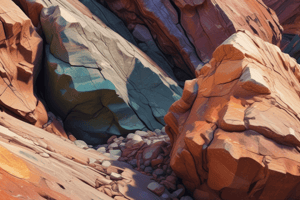Podcast
Questions and Answers
Which of the following is NOT an example of a metamorphic rock?
Which of the following is NOT an example of a metamorphic rock?
- Granite (correct)
- Slate
- Marble
- Gneiss
How do temperature and pressure influence the formation of metamorphic rocks?
How do temperature and pressure influence the formation of metamorphic rocks?
- By inducing chemical reactions within rocks (correct)
- By weakening the rock structure
- By cooling the rocks rapidly
- By creating liquid magma
What are igneous rocks primarily formed from?
What are igneous rocks primarily formed from?
- The solidification of molten rock material (correct)
- Sediments
- Erosion
- Metamorphic processes
Which factors determine the type of igneous rock formed?
Which factors determine the type of igneous rock formed?
What is the term used for magma that reaches the Earth's surface?
What is the term used for magma that reaches the Earth's surface?
How do intrusive igneous rocks form?
How do intrusive igneous rocks form?
What is the texture of extrusive igneous rocks, and why do they have that texture?
What is the texture of extrusive igneous rocks, and why do they have that texture?
Flashcards are hidden until you start studying
Study Notes
Formation of Metamorphic Rocks
- Metamorphic rocks originate from existing rocks that undergo transformation.
- Heat, pressure, and chemical reactions are the primary agents of change in the metamorphic process.
- These conditions alter the texture, mineral composition, and physical properties of the original rock.
Key Characteristics
- Texture changes can include foliation or a banded appearance depending on the pressure conditions.
- Mineral composition may evolve to form new minerals that were not present in the original rock.
- Physical properties such as hardness and density are often enhanced through metamorphism.
Examples of Metamorphic Rocks
- Marble is formed from limestone and is primarily composed of calcite.
- Slate originates from shale, displaying excellent cleavage properties and is often used in roofing and flooring.
- Gneiss is characterized by its banded appearance and is typically formed from granite or sedimentary rock under intense heat and pressure.
Studying That Suits You
Use AI to generate personalized quizzes and flashcards to suit your learning preferences.




